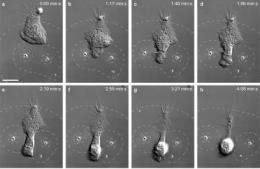Scientists guide immune cells with light and microparticles (w/ Video)

A team led by Yale University scientists has developed a new approach to studying how immune cells chase down bacteria in our bodies. Their findings are described in the November 15 issue of Nature Methods Advanced Online Publication.
When bacteria enter our bodies they secrete molecules, leaving behind chemical trails as they move through our system. It has been known for some time that immune cells follow these trails in order to hunt the bacteria. However, studying exactly how immune cells process these chemical signals has been challenging.
Now a team of scientists - led by Eric Dufresne, the John J. Lee Assistant Professor of Mechanical Engineering, and Holger Kress, a postdoctoral associate in the Yale School of Engineering & Applied Science - has developed a way to create artificial chemical trails that can be shaped in three dimensions over time. By controlling the chemical trails, the team was able to control the movements of neutrophils - immune cells in the blood - and study how they are able to respond to these signals.
The team used sponge-like microparticles, designed by the laboratory of Tarek Fahmy, associate professor of biomedical engineering at Yale, that mimicked bacteria by slowly releasing a characteristic bacterial "scent." They then moved these microparticles using focused beams of light to control the pattern of released chemicals over space and time, stimulating the immune cells to respond. The neutrophils can be seen following the microparticles on videos produced by the researchers.
"By fusing recent advances in optical and materials science, we've developed a new approach to control chemical microenvironments with light," said Dufresne, who developed holographic optical tweezers - the underlying technology used to manipulate the microparticles - in the late 1990s. "Until now, people have used optical tweezers to move physical objects. We've demonstrated that they can also be used to manipulate chemical gradients."
The team used two different chemicals, one of which attracted the cells and another that repelled them, to demonstrate how they could direct the neutrophils into moving along a path, either toward or away from the microparticles. They could also examine how the cells responded when there were conflicting signals sent by several of the artificial bacteria.
Chemotaxis - the migration of cells based on chemical signals in their environment - plays an important role in a number of biological processes and diseases beyond the immune system. "Understanding how cells move in response to chemical stimuli can help us better understand how a single egg develops into a complex organism or how brain cells grow into a network of neurons in a growing embryo, or how cancer cells spread through the body," Kress said. "This technique could give biologists insight into the ways many different types of cells respond to environmental stimuli in a wide range of situations."
Source: Yale University (news : web)



















